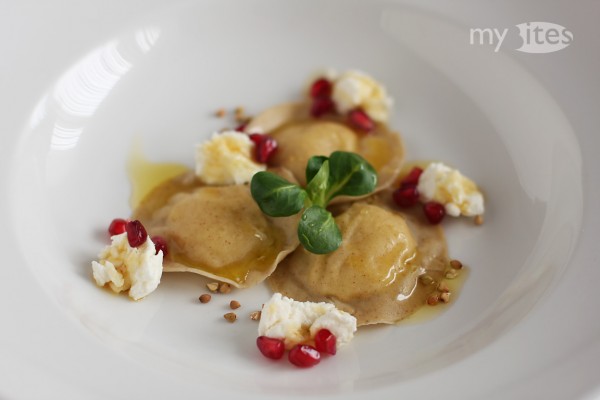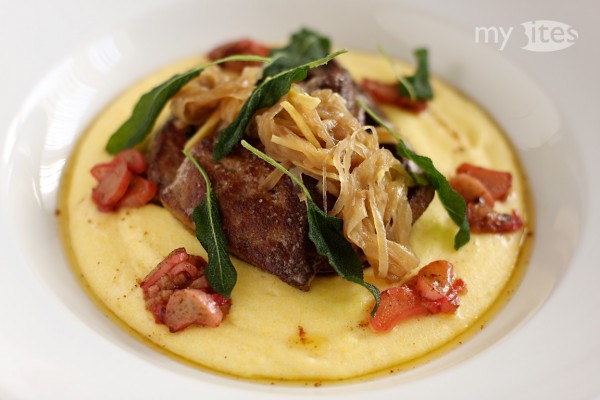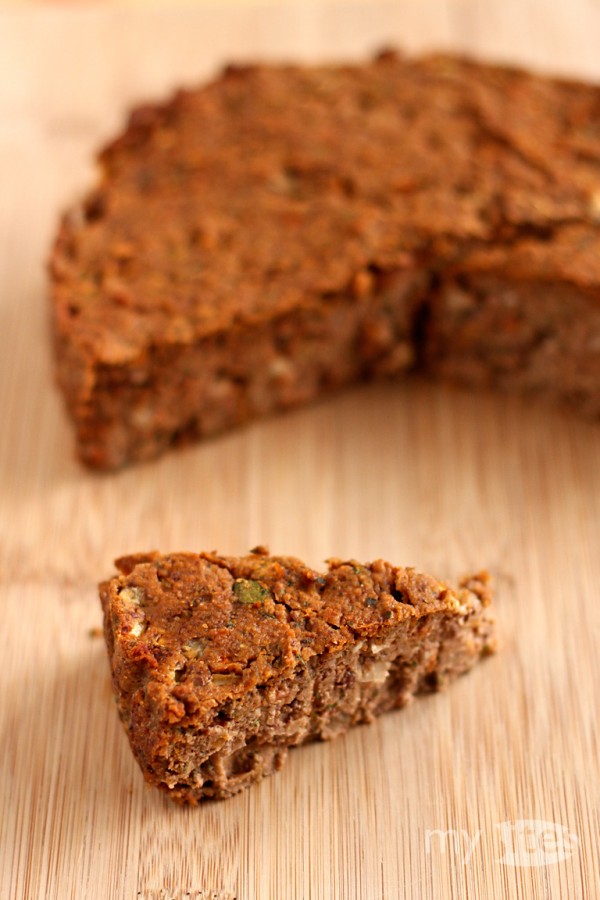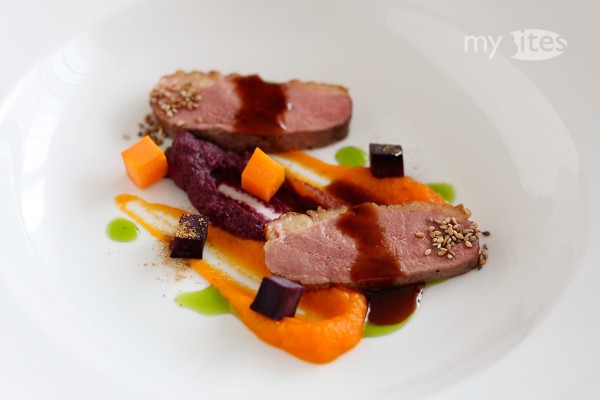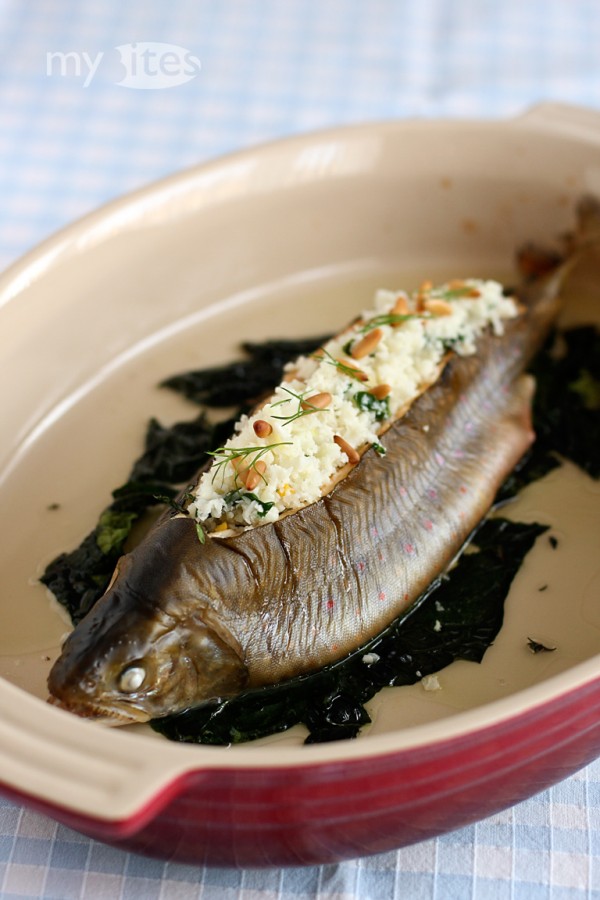Buckwheat is a very versatile ingredient. It can be cooked in water or stock, sprinkled on top of small buns and baked, or used as buckwheat flour for really flavorful pasta. To enhance the mild flavor of buckwheat, it should always be paired with smooth and light accompaniments. In the simple and light dish below I filled the buckwheat ravioli with a creamy celery root puree, which really allowed the nutty flavors of buckwheat to get into the foreground.
Category Archives: Main Course
Calf’s Liver with Ginger-Onion Marmalade
By now the local markets are stacked with a large variety of young and fresh vegetables, such as asparagus, radishes, carrots or rhubarb. The latter is categorized often as fruit, although it’s only the stalk of a plant. Probably it’s considered as a fruit, because it’s mainly consumed sweetened by sugar or syrups. Savory interpretations of rhubarb are rare, which is unfortunate, because the tart aroma of rhubarb adds freshness to a plate and replaces vinegars perfectly in spring or summer dishes. In this dish below I used rhubarb as a refreshing sour element.
Coconut Trout Confit with Beetroot Fondant
It’s almost 4 years now that I filleted a whole fish for the first time in my life. Since then I stopped counting the number of fish I’ve filleted and really gained routine in getting clean and beautiful cuts as result. Nowadays I prefer to buy whole fish at the local market, because this way I can use the bones, head, tail and fins as well to cook a flavorful fish stock, which really enhances sauces, risottos and soups. I prefer to buy local and traditional fish such as trout, char or carp. Sea fish are no options for me, because I don’t have any reliable source for buying fresh seafood, and my hometown Erlangen is simply too far away from the sea.
Regarding the connection between seafood consumption and the distance to the sea, I had a surprising experience a few years ago in Italy, which I like to bring up every time I’m asked about seafood. I was lucky to get a publication accepted at a major conference in computer science, which was held in the beautiful city of Florence. Of course, I used the lunch breaks and the evenings to explore the local restaurant scene. I was even more fortunate having a receptionist at my hotel who was actually a native Florentine citizen. As almost everybody in Italy, he loved to eat, and especially to eat well. So from the first day on I consulted him which restaurant he recommends me to visit. I wasn’t a regular tourist, I really wanted to get to know the real local cuisine. He always told me only the next location I should go to and based on my report the next day he recommended me the next place to visit. This tactic was quite comprehensible, because I could have been a usual tourist, who actually might have been afraid of tripe, wild boar or other local specialties. But he pretty soon learned, that I was after the real local cuisine.
Vegan Nutcake
Last year in December a friend of mine, Anna called for a “vegastromania month“, where she invited everyone to cook at least one vegetarian or even vegan meal during the Christmas preparations. The main goal of this project was to make people think about vegetarian dishes and what they are eating everyday – which is usually far too much meat. The participants were allowed to submit any kind of recipe except for desserts, because they are mostly naturally vegetarian, less healthy and we already have more than enough of sweet recipes. Anna also assembled some famous Hungarian vegetarians, who picked their favorite recipe. The winner was invited to a very special vegetarian dinner at Anna’s home and also recieved a voucher for an ayurvedic massage. Fortunately, I got picked by the jury, so this January I had a wonderful dinner with Anna, Ági and Noémi. One of the dishes Anna served at this dinner was Mrs. Myrtleberry’s nutcake, which was quite an extraordinary and surprising experience. First, it’s absolutely delicious. But its texture was even more interesting, because it tasted just like minced meat – although there was no meat in the cake at all.
Duck Breast with Purple and Orange Carrot Puree
Winter is passing by slowly and spring gets in its place. This is a very interesting time of the year, not only because of the awakening of the nature, but also from a culinary point of view. At this time of year, both winter-stored and fresh spring versions of the same ingredients can be found at local markets. While the winter vegetables usually require a lot more cooking time, spring vegetables tend to get soft within minutes. In this dish I combined the last purple carrots from winter with the first orange ones of spring.
Char with Cauliflower Couscous
Have you ever wondered why fish in Germany – and almost everywhere in Europe – is gutted with a cut at its belly? It’s straightforward to some extent, because all innards are located in the belly, and by removing them along with the gills, the fish can be kept refrigerated 3-4 days longer. In China I noticed that fish are usually kept alive in restaurants and killed to order. An even more interesting experience was to see that all fish was cut open and gutted from its back, so the bellies of the fish were always completely intact. I liked this back filleting method simply because the possibilities of stuffing and serving a whole fish. Unfortunately, at the local market in Erlangen they don’t sell any fish alive and all of them are already gutted via a cut along their bellies. So my filleting from the back basically resulted in two fillets held together by the head and the tail of the fish, but made the seasoning of the whole fish a lot simpler and more precise.
